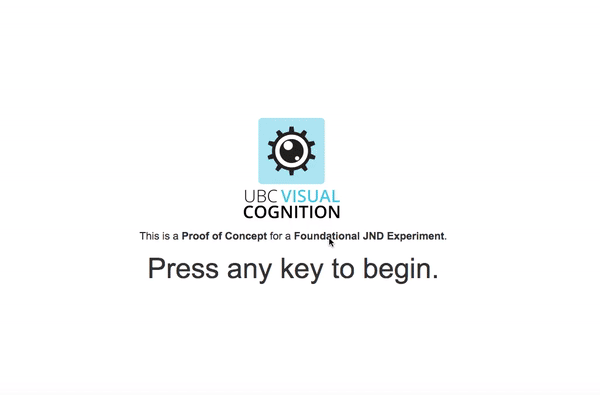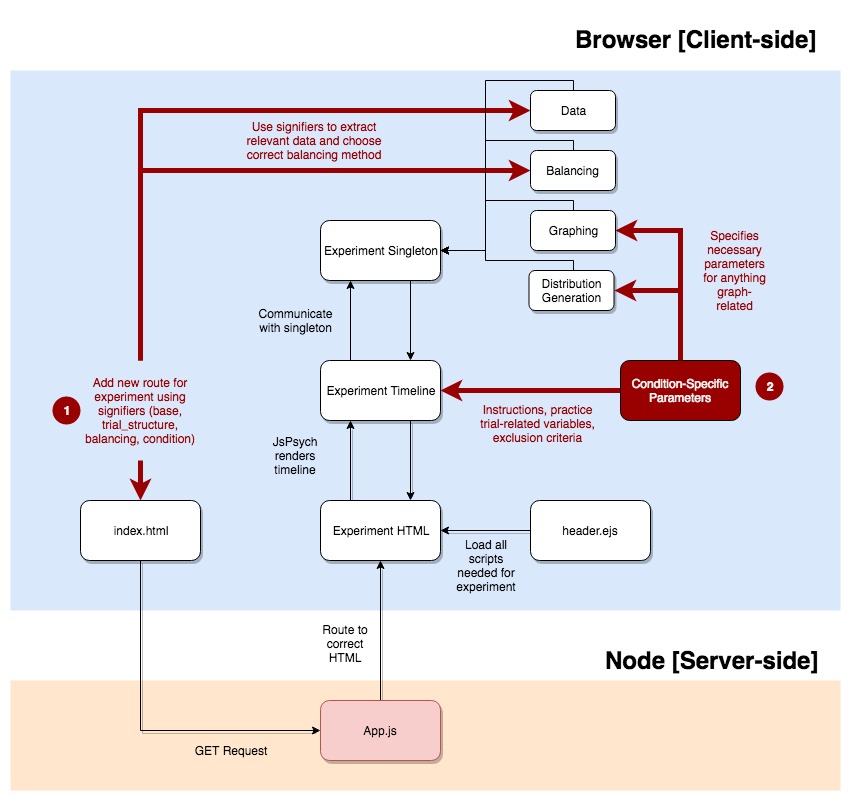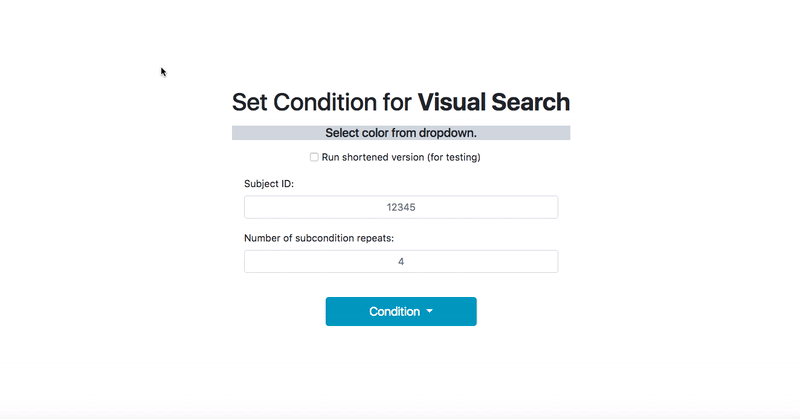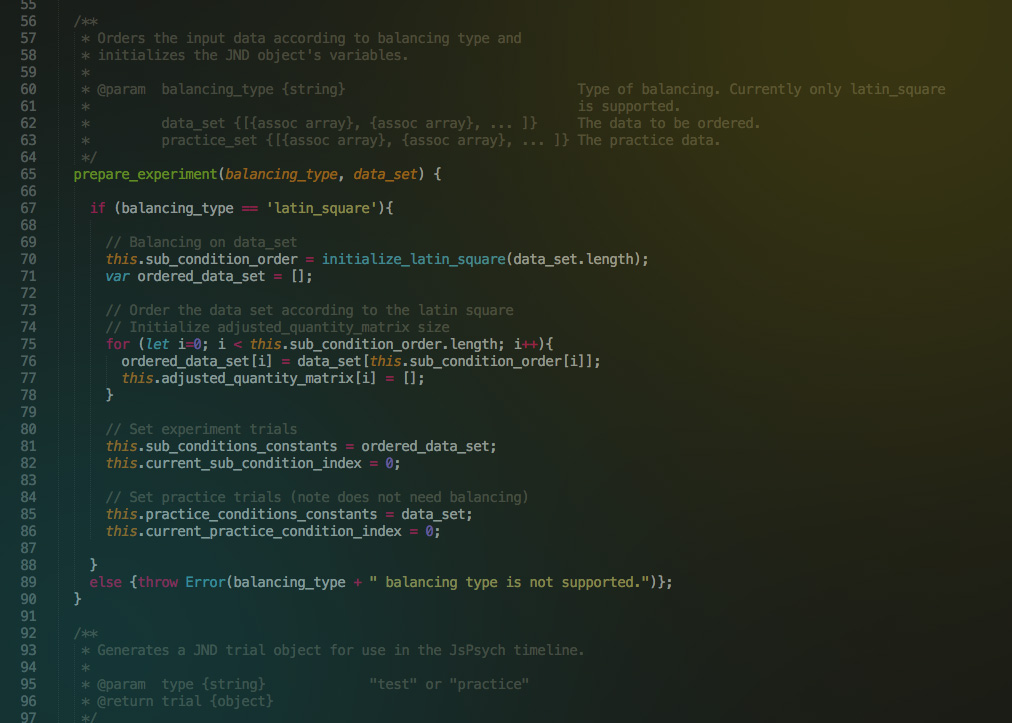
VCL Framework Development
WHEN:
May 2018 - July 2019
WHAT:
Independent Studies in Computer Science
WHERE:
University of British Columbia, BC, Canada
TOOLS:
May 2018 - July 2019
WHAT:
Independent Studies in Computer Science
WHERE:
University of British Columbia, BC, Canada
TOOLS:
- Javascript
- Node.js
- D3.js
- JsPsych
- Express.js
- EJS
- Git
- HTML/CSS
This project involves modernizing the Visual Cognition Lab's existing Java codebase to utilize modern web frameworks. The old codebase has suffered from a lack of software maintenance and documentation updates, which have led to many researchers having to "hack" a version of the codebase to suit their needs, resulting in a proliferation of bugs and poor extensibility.
To develop the new web application, we are employing a mixed methods design with a qualitative approach to understand the existing technologies available to us, in which we are documenting the strengths and limitations at each step/iteration.
Special thanks to Prof. Ronald Rensink, Madison Elliott, and all the other VCL members!
To develop the new web application, we are employing a mixed methods design with a qualitative approach to understand the existing technologies available to us, in which we are documenting the strengths and limitations at each step/iteration.
Special thanks to Prof. Ronald Rensink, Madison Elliott, and all the other VCL members!
The Challenge:
Design the new framework in such a way so that it is easy to learn, use and extend by other researchers, who may not necessarily have any formal programming experience, but must implement new visual experiments.
May 2018
Literature Review &
Literature Review &
Information Gathering
Performed a literature review on potential web frameworks used in other vision science labs. Potential tools considered included JsPsych, D3.js, PsychoPy, E-Prime, MATLAB.
Interviewed other members of the lab about their experiences with the current codebase, and how they were implementing new experiments. Many researchers were "hacking" the code to fit their needs, making the codebase buggy.
Interviewed other members of the lab about their experiences with the current codebase, and how they were implementing new experiments. Many researchers were "hacking" the code to fit their needs, making the codebase buggy.

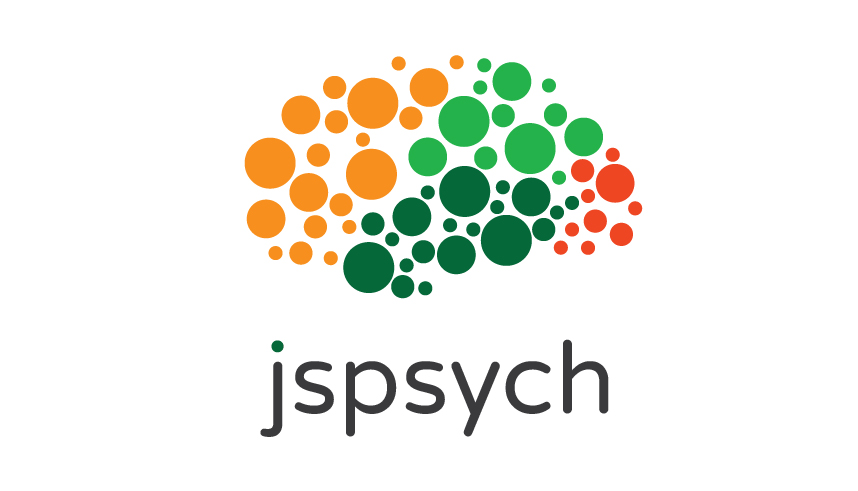
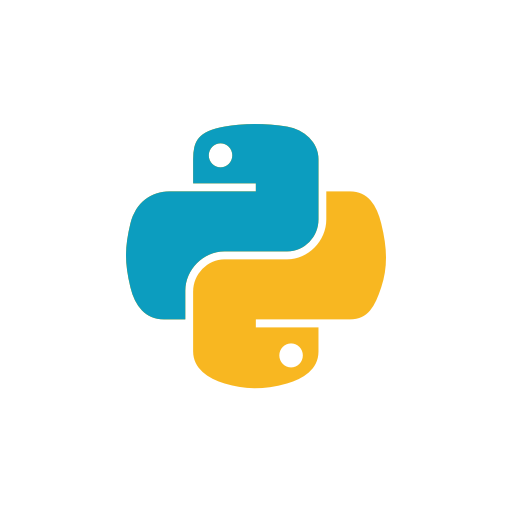
June - July 2018
Proof of Concept Experiments
Narrowed potential frameworks to JsPsych for experimental control flow and D3.js for visualization, with Node.js for backend. Implemented POCs to assess feasibility of migrating two of their foundational experiments, JND (Just
Noticeable Difference) and Stevens.
August 2018
Piloting
POCs were piloted by researchers in the lab to ensure that behavior and output was expected, and equivalent to that produced by the current Java framework.
Any unexpected visual and data output was identified.
Issues were logged and some bug-fixing work was done.
Any unexpected visual and data output was identified.
Issues were logged and some bug-fixing work was done.
September - October 2018
Literature Review &
Literature Review &
Specification Planning
Performed literature review on end-user programming methods and software development for scientific software. Considering viability of HCI-centric approach.
Outlined specifications for the codebase migration. Analyzed structure of different forms of visual experiments in the original codebase, and validated understanding of the experimental methodology by interviewing researchers.
Outlined specifications for the codebase migration. Analyzed structure of different forms of visual experiments in the original codebase, and validated understanding of the experimental methodology by interviewing researchers.
November 2018
Informal Exploratory Study
Before commencing formal development of the new codebase with members of the team, there was a need to validate whether additional development effort is needed to make the JsPsych framework more accessible for non-computer science majors.
Usability of the JsPsych framework was assessed through an informal exploratory study. In pairs, members of the research team implemented new visual experiments (visual search and numerosity) solely using Javascript, JsPsych and HTML/CSS, and were therefore separate from the Node application. We wanted to isolate JsPsych as much as possibile to assess its usability from an end-user programmer perspective.
Feedback suggests that JsPsych is easy to use, and greatly facilitates setting up the experimental structure. What was difficult is that JsPsych does not provide any stimuli-generation functionality, so without using D3.js, visualization had to be handled by custom HTML/CSS and additional helper scripts. This therefore strengthened the need to use D3.js to support the data visualization component.
Usability of the JsPsych framework was assessed through an informal exploratory study. In pairs, members of the research team implemented new visual experiments (visual search and numerosity) solely using Javascript, JsPsych and HTML/CSS, and were therefore separate from the Node application. We wanted to isolate JsPsych as much as possibile to assess its usability from an end-user programmer perspective.
Feedback suggests that JsPsych is easy to use, and greatly facilitates setting up the experimental structure. What was difficult is that JsPsych does not provide any stimuli-generation functionality, so without using D3.js, visualization had to be handled by custom HTML/CSS and additional helper scripts. This therefore strengthened the need to use D3.js to support the data visualization component.
>> Github to the Visual Experiments <<
December 2018
Running Numerosity & Visual Search
These two experiments (which were developed as part of the exploratory study) were piloted to ensure correct behavior and data output.
I designed the UI to facilitate easy testing and customizability, especially for trial number, as we needed to estimate how many sub-conditions could be run given 1 hour of a participant's time.
After piloting, these tasks were run on actual participants, and the data collected were used in a VSS abstract submission.
I designed the UI to facilitate easy testing and customizability, especially for trial number, as we needed to estimate how many sub-conditions could be run given 1 hour of a participant's time.
After piloting, these tasks were run on actual participants, and the data collected were used in a VSS abstract submission.
January - March 2019
Restructuring
At this point in time, the application was stable enough to perform some restructuring to the architecture. This refactoring involved: (a) modularizing components, such as graphing, balancing, and instructions of an experiment, and (b) creating a config system that allowed for proper documentation and input of any experimental and graphical properties.
April 2019
Dynamic Documentation
One of the greatest issues from the previous codebase was that over time, researchers and developers alike failed to update documentation. I implemented a system in which the documentation is dynamic - what this means is that in order to create a new experiment or condition, the individual must update configuration files along the way, which help the system create and render the experiment. However, these config files ALSO are used to extract necessary information for the documentation.
Essentially, this system allows users to update the docs WITHOUT having the need to actually touch the documentation code at all!
Essentially, this system allows users to update the docs WITHOUT having the need to actually touch the documentation code at all!
Conclusions:
This project really opened my eyes to central issues faced by any research lab that relies on programming to implement experiments. Due to the evolving nature of research, it is difficult for researchers to produce concrete specifications, while some do not have sufficient programming experience to code their experiments from scratch.
I implemented this framework in the hopes that the researchers of VCL, whether new or experienced in programming, could easily implement new conditions and experiments. This project truly made me appreciate how programmers are "users", and that HCI methodology must certainly be utilized to improve the developer experiences.
